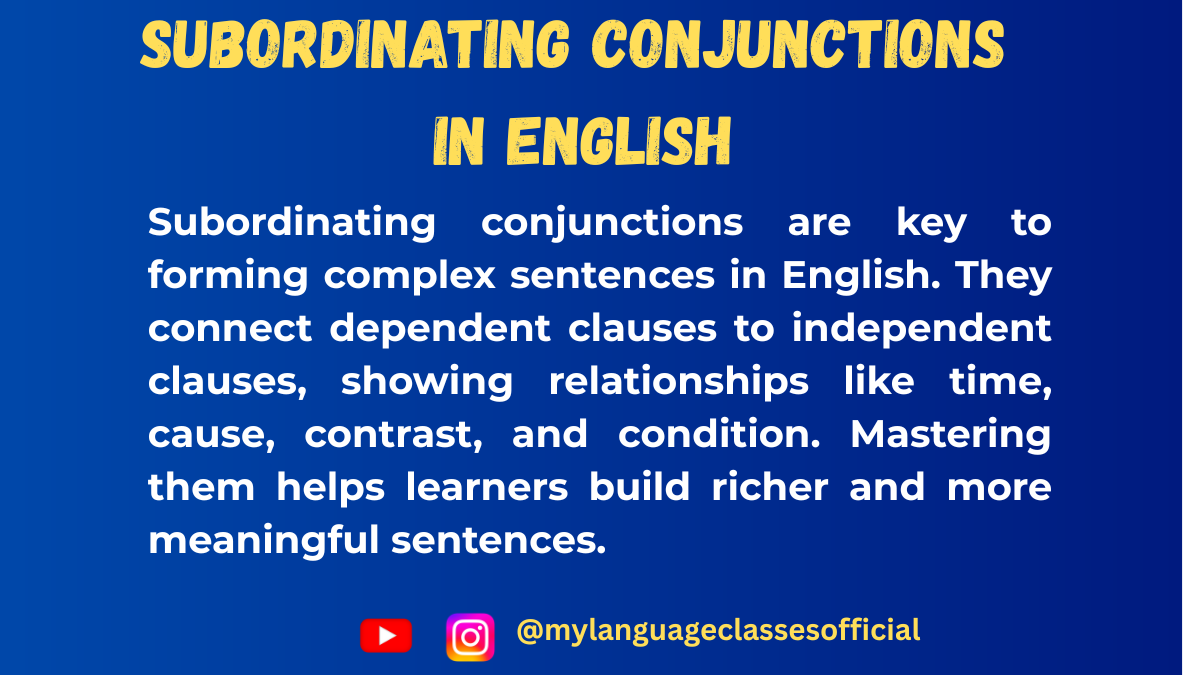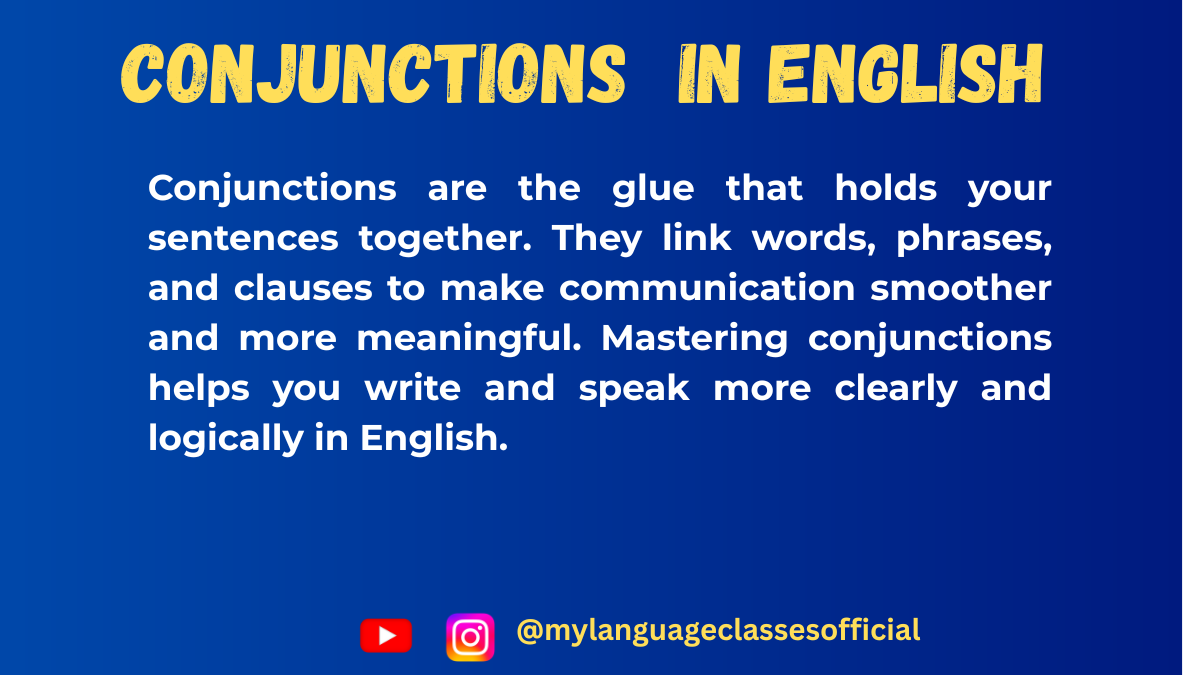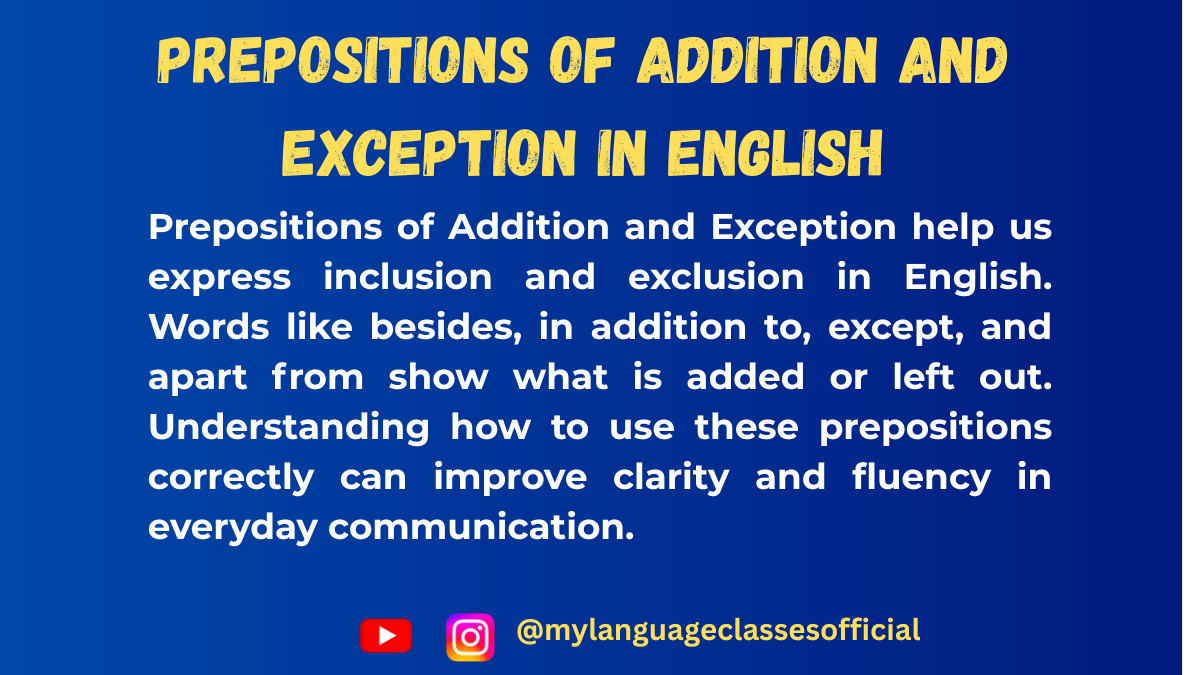Your cart is currently empty!
Tag: English Grammar Rules
-
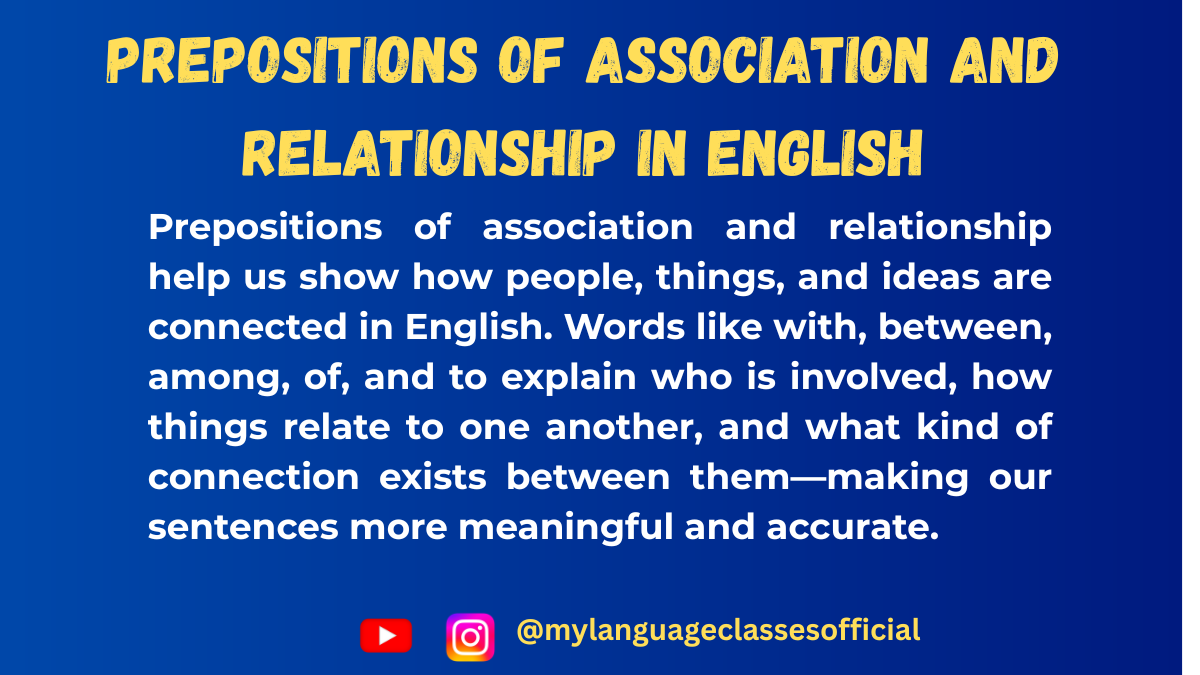
Preposition of Association and Relationship in English
Prepositions are small but mighty words that play a crucial role in connecting ideas and providing context in sentences. Among the various types of prepositions, Prepositions of Association and Relationship are particularly important because they help us describe how people, things, or ideas are connected. In this blog post, we’ll explore the usage of these prepositions in detail, provide examples, and offer practical exercises to help you master them.
What Are Prepositions of Association and Relationship?
Prepositions of Association and Relationship are used to indicate a connection or relationship between two or more entities. These prepositions help clarify how people, objects, or concepts are linked, whether through partnership, belonging, or interaction.
Usage of Prepositions of Association and Relationship
These prepositions are used in various contexts, including:
- Partnerships and Collaborations: To describe working or being together.
- Example: She works with a team of experts.
- Ownership or Belonging: To show possession or association.
- Example: This is the book of my friend.
- Relationships Between People: To describe familial, romantic, or social connections.
- Example: He is married to Sarah.
- Connections Between Objects or Ideas: To explain how things are related.
- Example: The key to success is hard work.
- Membership or Inclusion: To indicate being part of a group.
- Example: She is a member of the club.
- Origin or Source: To show where something or someone comes from.
- Example: This gift is from my grandmother.
List of Prepositions of Association and Relationship
Here’s a table of common prepositions of association and relationship, along with example sentences:
Preposition Example Sentences With 1. She went to the party with her friends.
2. He is collaborating with a renowned scientist.Of 1. The color of the sky is blue.
2. This is a picture of my family.To 1. She is married to a doctor.
2. The answer to the question is simple.From 1. This letter is from my teacher.
2. He hails from a small village.For 1. This gift is for you.
2. She has a deep love for animals.About 1. They were talking about the project.
2. This book is about ancient history.Among 1. The secret was shared among friends.
2. She was among the top performers.Between 1. The agreement between the two companies was signed.
2. The conversation between them was intense.By 1. The book was written by a famous author.
2. The painting was created by an artist.Against 1. She leaned against the wall.
2. The decision was against his wishes.
More Example Sentences
- She is always with her best friend.
- The sound of the waves is soothing.
- He is loyal to his team.
- This recipe is from my grandmother.
- I bought a gift for my sister.
- They were arguing about the rules.
- The prize was divided among the winners.
- There is a strong bond between the twins.
- The song was composed by a talented musician.
- The protest was against the new policy.
Fill in the Blanks
Test your understanding by filling in the blanks with the correct preposition of association and relationship:
- She is traveling ___ her colleagues.
- This is a photo ___ my childhood.
- He is always kind ___ animals.
- The letter was ___ the manager.
- The discussion was ___ the new project.
- The cake was shared ___ the children.
- The agreement ___ the two parties was finalized.
- The novel was written ___ a famous author.
- She stood ___ the door, waiting for him.
- The decision was ___ his will.
Answers to Fill in the Blanks
- with
- of
- to
- from
- about
- among
- between
- by
- against
- against
Things to Keep in Mind
- Articles and Gender: Prepositions of association and relationship are not affected by gender or articles. They remain the same regardless of whether the noun is masculine, feminine, singular, or plural.
- Example: with the boy, with the girl, with the books.
- Context Matters: The choice of preposition depends on the context of the sentence. For example, with is used for companionship, while of is used for possession.
- Avoid Overusing Prepositions: While prepositions are essential, overusing them can make sentences clunky. Ensure each preposition adds value to the sentence.
- Practice Regularly: The more you practice, the more natural using these prepositions will become.
Conclusion
Prepositions of Association and Relationship are indispensable tools for expressing connections and relationships in English. By understanding their usage and practicing regularly, you can enhance your communication skills and write or speak more effectively. Remember to pay attention to context and keep practicing with examples and exercises.
If you enjoyed this lesson, be sure to check out more posts like this on my blog at My Language Classes. Don’t forget to subscribe my YouTube channel and follow me on Instagram for the latest language learning tips and lessons. Leave a comment below to share your thoughts, or ask any questions you have about nouns.
Happy learning! 😊
- Partnerships and Collaborations: To describe working or being together.
-
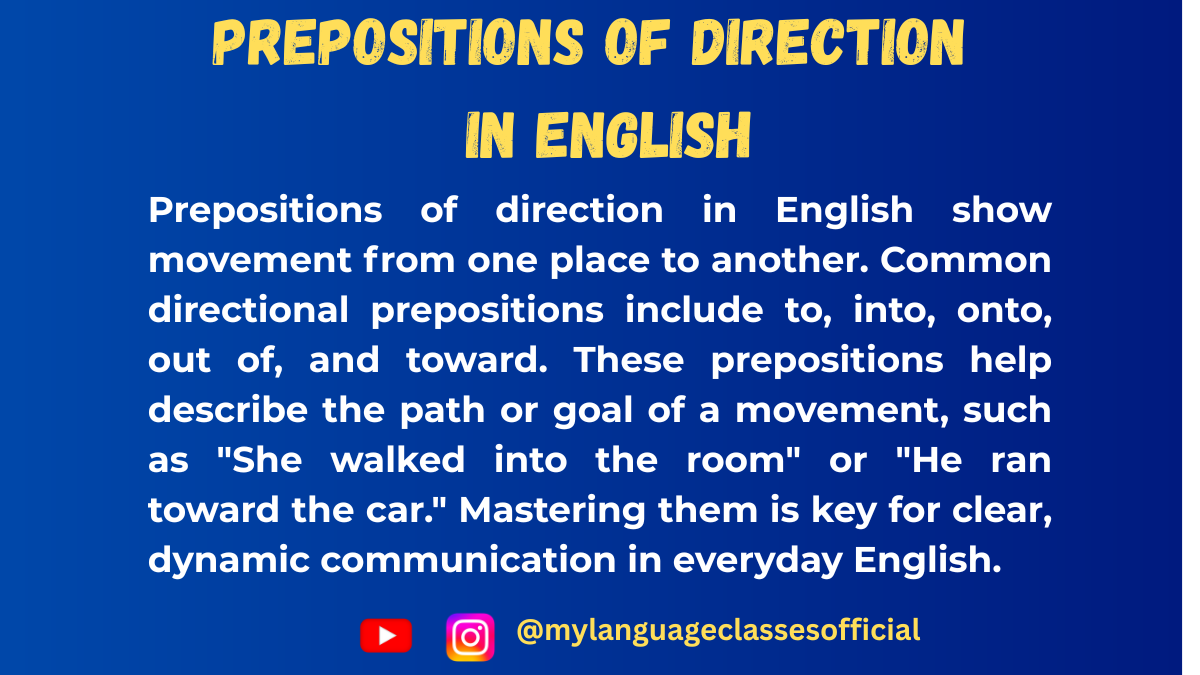
Prepositions of Direction in English
Prepositions of direction indicate movement from one place to another. They are essential in describing how something moves or changes position concerning another object.
List of Prepositions of Direction and Their Usage
Preposition Meaning Example Sentence 1 Example Sentence 2 To Movement towards a destination She went to the park. He sent a letter to his friend. Into Movement from outside to inside She walked into the room. The cat jumped into the box. Onto Movement towards a surface The child climbed onto the table. He jumped onto the bed. Out of Movement from inside to outside She ran out of the house. He took his phone out of his pocket. Towards Movement in the direction of something She moved towards the door. He walked towards me with a smile. Away from Movement in the opposite direction She walked away from the fire. The dog ran away from the stranger. Up Movement from a lower position to a higher one He climbed up the hill. The plane soared up into the sky. Down Movement from a higher position to a lower one The ball rolled down the hill. She walked down the stairs. Across Movement from one side to another He swam across the river. The children ran across the street. Over Movement above something The bird flew over the lake. He jumped over the fence. Under Movement beneath something The dog crawled under the table. The ball rolled under the chair. Along Movement following a path He walked along the beach. The car drove along the highway. Past Movement beyond a certain point They walked past the school. He drove past the mall. Through Movement within a space from one end to another She ran through the tunnel. The wind blew through the trees. Around Movement in a circular direction He walked around the park. The car drove around the roundabout.
More Example Sentences
- The boy ran to his mother as soon as he saw her.
- She poured the coffee into the cup carefully.
- He jumped onto the boat from the dock.
- The cat ran out of the house when the door was open.
- The athlete sprinted towards the finish line.
- They moved away from the dangerous area.
- The monkey climbed up the tree quickly.
- She walked down the street, enjoying the fresh air.
- He drove across the city to meet his friend.
- The plane flew over the mountains.
Fill in the Blanks
- She jumped ___ the swimming pool.
- He walked ___ the tunnel to reach the other side.
- The dog ran ___ the street to chase the cat.
- The helicopter flew ___ the buildings.
- He climbed ___ the ladder to fix the roof.
- The train passed ___ the bridge.
- The girl moved ___ the stage to receive her award.
- The kids walked ___ the road to reach school.
- The car drove ___ the highway without stopping.
- He ran ___ the hill with great speed.
Answers:
- into
- through
- across
- over
- up
- over
- towards
- across
- along
- down
Things to Keep in Mind
- Prepositions of direction always describe movement from one place to another.
- Some prepositions like to and towards may seem similar but have different uses (e.g., “to” specifies the destination, while “towards” indicates movement in a direction without necessarily reaching the destination).
- Prepositions such as into and onto describe entering or moving onto a surface, while in and on describe static positions.
- Over and under describe movement above and below something, respectively.
- Across and through both describe movement, but “across” is typically for flat surfaces, while “through” indicates movement within an enclosed space.
Conclusion
Prepositions of direction are essential for clear communication when describing movement and changes in position. Understanding their proper usage will enhance both written and spoken English. By practicing these prepositions in different contexts, you can develop a natural sense of their application and improve your fluency. Keep practicing with more sentences and exercises to master this important grammar topic!
If you enjoyed this lesson, be sure to check out more posts like this on my blog at My Language Classes. Don’t forget to subscribe my YouTube channel and follow me on Instagram for the latest language learning tips and lessons. Leave a comment below to share your thoughts, or ask any questions you have about nouns.
Happy learning! 😊
-
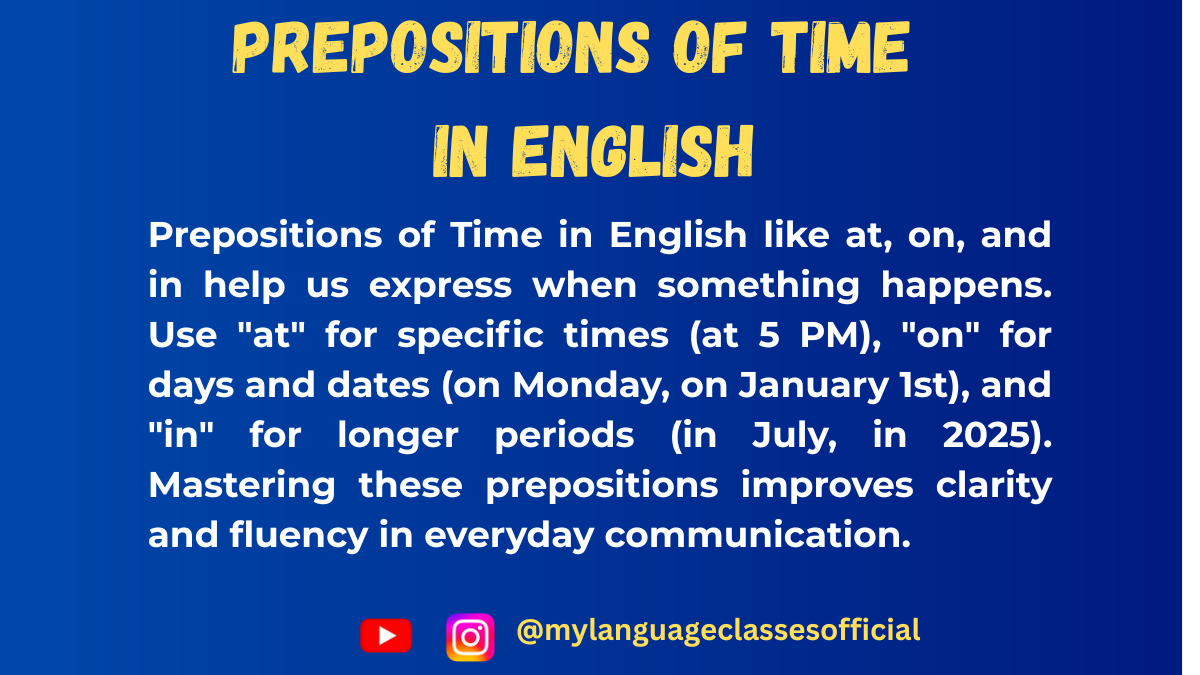
Prepositions of Time in English
Prepositions of time are essential in English grammar as they help us understand when an event occurs. They connect nouns or pronouns with time-related elements, clarifying specific moments, durations, or general time frames. In this blog, we will explore the different prepositions of time, their usages, examples, and important points to remember.
List of Prepositions of Time and Their Usage
Below is a list of common prepositions of time along with their specific usage and example sentences.
Preposition Usage Example Sentence 1 Example Sentence 2 At Specific time of the day, festivals, and specific points in time I wake up at 6 AM. We will meet at Christmas. On Specific days and dates I was born on Monday. The party is on 5th June. In Months, years, centuries, long periods I was born in December. We will visit Japan in 2025. By A deadline or before a certain time You must submit the report by Monday. She will be home by 7 PM. Before An event occurring earlier than a certain time Finish your work before sunset. He arrived before me. After An event occurring later than a certain time We will go out after lunch. She arrived after the meeting started. Since A point in time until now She has been here since morning. I have lived here since 2010. For Duration of time She stayed here for two weeks. I have known him for ten years. During Within a specific period He slept during the lecture. We traveled during the holidays. From…to A specific time range The shop is open from 9 AM to 5 PM. The movie runs from 6 PM to 8 PM. Until/till Up to a certain point in time Wait here until I return. The shop is open till midnight. Within Before the end of a specific period The work will be done within an hour. We will reach there within two days.
More Example Sentences
- She will call me at noon.
- The meeting is scheduled on Tuesday.
- We moved to this city in 2018.
- Complete your assignment by tomorrow.
- The baby slept before dinner.
- We will go out after the rain stops.
- She has lived here since 2015.
- He was on vacation for a month.
- The crowd cheered during the match.
- The library is open from 9 AM to 7 PM.
Things to Keep in Mind
- At is used for specific points in time, while on is for specific days and dates.
- In is used for months, years, centuries, and longer periods.
- Since refers to a specific point in time, while for is used for a duration.
- By means “no later than,” whereas before means “earlier than.”
- Until/till is used when something continues up to a point in time.
- From…to marks the beginning and end of a time period.
- During is used to indicate something happening within a specific period.
- Within suggests a task or event will occur before a given period ends.
Fill in the Blanks
- The train will arrive ___ 6 PM.
- She was born ___ March.
- We will go on a trip ___ summer vacation.
- He stayed in London ___ two years.
- You should submit the form ___ Monday.
- The lights went out ___ the movie.
- I have been waiting here ___ morning.
- We will complete the project ___ two weeks.
- They will be back home ___ midnight.
- The concert will be held ___ Friday night.
Answers
- at
- in
- during
- for
- by
- during
- since
- within
- at
- on
Conclusion
Understanding and correctly using prepositions of time is crucial for clear and precise communication. These prepositions help in framing accurate sentences, making conversations and writing more effective. By practicing their usage and remembering their specific contexts, you can enhance your command over the English language. Keep practicing, and soon, using prepositions of time will become second nature!
If you enjoyed this lesson, be sure to check out more posts like this on my blog at My Language Classes. Don’t forget to subscribe my YouTube channel and follow me on Instagram for the latest language learning tips and lessons. Leave a comment below to share your thoughts, or ask any questions you have about nouns.
Happy learning! 😊
-

Prepositions of Place in English
Prepositions of place are essential in English as they help indicate the location of people, objects, or actions. Understanding them correctly enhances fluency and accuracy in spoken and written English. This article will provide a detailed explanation, a categorized list, examples, exercises, and essential things to remember while using prepositions of place.
What is a Preposition of Place?
A preposition of place is a word used to show the location or position of an object concerning another object. These prepositions answer the question “Where?” and are essential for clear communication.
List of Prepositions of Place and Their Usage
Below is a list of commonly used prepositions of place along with their meanings and example sentences.
Preposition Usage Example 1 Example 2 In Inside a space, area, or container The books are in the bag. She is in the room. On On the surface of something The book is on the table. There is a painting on the wall. At A specific point or location She is at the bus stop. We met at the restaurant. Under Below something The cat is under the table. He hid under the bed. Over Above something without touching The lamp is over the table. The bridge is over the river. Above Higher than something The clock is above the door. Planes fly above the clouds. Below Lower than something His shoes are below the bed. The valley is below the mountain. Between In the middle of two things The park is between the school and the mall. She sat between her friends. Next to Beside something The school is next to the hospital. She is sitting next to her brother. Behind At the back of something The car is behind the building. There is a garden behind the house. In front of Before something The teacher is in front of the class. There is a park in front of my house. Inside Within an enclosed space The keys are inside the drawer. She stayed inside the house. Outside Opposite of inside The kids are playing outside the house. There is a cat outside the shop. Near Close to something There is a bank near my house. She lives near the station. Far from Distant from something His school is far from his home. The hotel is far from the airport.
More Example Sentences:
- There is a mirror on the wall.
- The plane is flying above the clouds.
- She is waiting at the entrance.
- The ball is under the chair.
- The bakery is next to the supermarket.
- He kept his phone inside his pocket.
- The children are playing outside the house.
- The library is between the coffee shop and the bank.
- The painting is hanging over the sofa.
- There is a tree behind the house.
Fill in the Blanks:
- The cat is ___ the table.
- The park is ___ the school and the library.
- She is waiting ___ the bus stop.
- The ball rolled ___ the couch.
- The students are sitting ___ the teacher.
- The books are ___ the bag.
- The hotel is ___ the beach.
- The keys are ___ the drawer.
- He is standing ___ the door.
- The stars are shining ___ the sky.
Answers:
- under
- between
- at
- under
- in front of
- in
- near
- inside
- behind
- above
Things to Keep in Mind:
- Articles: Use definite and indefinite articles appropriately (e.g., “in a house” vs. “in the house”).
- Gender & Number: Prepositions of place do not change based on gender but may be influenced by singular/plural usage (e.g., “between two buildings”).
- Fixed Expressions: Some prepositions are part of set phrases, such as “at home,” “on the street,” or “in bed.”
- Context Matters: Some prepositions can change meaning based on the context (e.g., “on the bus” vs. “in the car”).
- Prepositions vs. Adverbs: Some words can function as both prepositions and adverbs. For example, “inside” can be a preposition in “inside the house” but an adverb in “Come inside!”
Conclusion
Prepositions of place are fundamental in English grammar and crucial for describing locations accurately. By understanding their usage and practicing them through exercises, you can significantly improve your English fluency. Keep practicing with real-life situations, and soon, using prepositions of place will become second nature!
If you enjoyed this lesson, be sure to check out more posts like this on my blog at My Language Classes. Don’t forget to subscribe my YouTube channel and follow me on Instagram for the latest language learning tips and lessons. Leave a comment below to share your thoughts, or ask any questions you have about nouns.
Happy learning! 😊
-
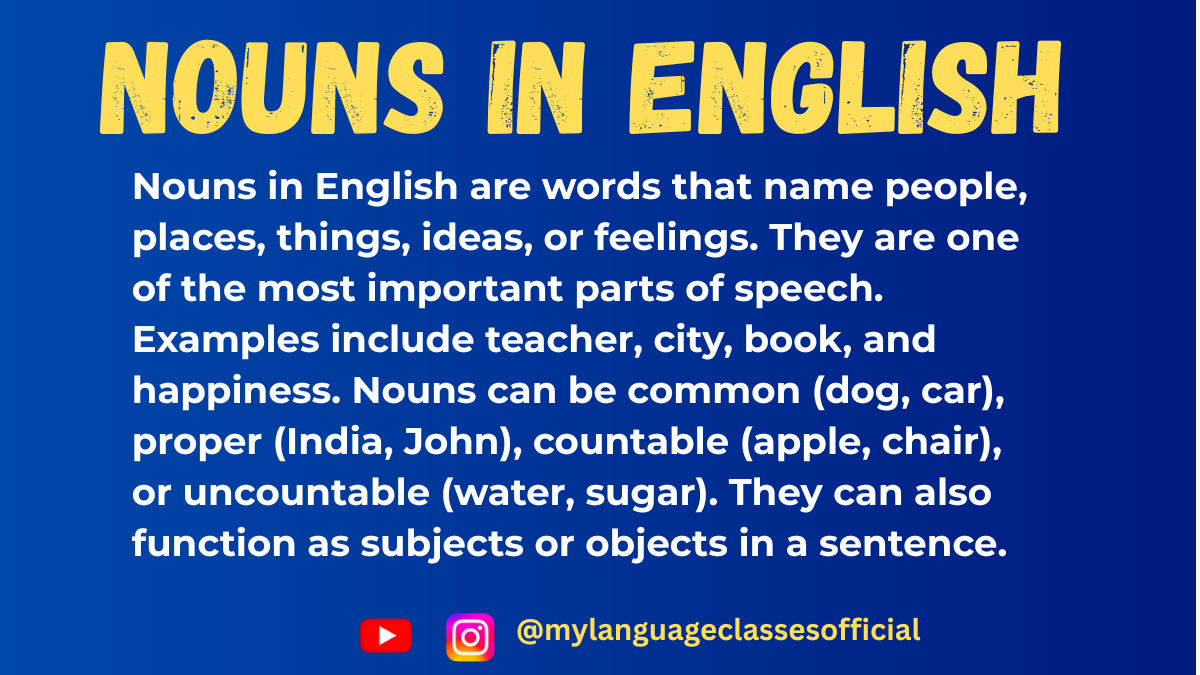
Mastering Nouns in English: The Ultimate Guide for Beginner Level Language Learners
Have you ever wondered what makes up the building blocks of the English language? Nouns are one of the first and most important grammar points every learner should know. Whether you’re talking about your family, your favorite places, or your dreams, you are using nouns—often without even realizing it!
In this guide, we’ll take you on a fun and friendly journey to understand what nouns are, how they work, and how to use them like a pro. If you’ve ever felt unsure about common nouns, proper nouns, countable or uncountable nouns, or just want to build a stronger foundation in English grammar, this is your one-stop resource. Perfect for students, curious minds, or anyone looking to brush up on their English skills.
Here’s what we’ll explore in this complete guide:
- Real-life examples of how nouns are used in everyday conversations
- Clear explanations of noun usage in different situations
- Easy-to-remember grammar rules
- Common mistakes and how to avoid them
- Exercises to test your knowledge
By the end of this blog, you’ll feel confident using nouns in English naturally and accurately—whether you’re writing, speaking, or just thinking in English. Let’s dive in and unlock the power of English nouns together!
Common Expressions Using Nouns in Everyday English
Nouns are everywhere! We use them every time we speak, write, or even think. Here are 10 real-life, simple, and relatable sentences that show how nouns naturally appear in everyday conversations. These examples are perfect for learners to see how nouns work in different settings.
10 Real-Life Sentences Using Nouns:
- My dog loves to play in the park every evening.
- Sarah is reading an exciting new book about dinosaurs.
- We had a delicious lunch at that Italian restaurant yesterday.
- The weather today is perfect for a picnic.
- I lost my keys somewhere in the living room.
- He dreams of becoming a pilot and traveling the world.
- Please pass the salt and pepper, they’re on the table.
- That movie we watched last night was really funny.
- Education is the most powerful tool you can use to change the world.
- My little brother is afraid of the dark but loves his teddy bear.
In these examples, you can spot different types of nouns: people (Sarah, brother), places (park, restaurant), things (book, table), ideas (education), and more. These everyday uses show just how essential nouns are to English communication.
Usage: When Do We Use Nouns in English?
Nouns are the naming words of English. They help us talk about people, places, things, animals, and ideas. You’ll find nouns being used in almost every sentence because they are the main parts that give meaning to what we are talking about.
Here are the most common situations where nouns are used:
🟢 To name a person
We use nouns to talk about people by name or by role.
- Example: Emma is my best friend.
- Example: The teacher gave us homework.
🟢 To name a place
Nouns help us talk about locations—both general and specific.
- Example: We are going to the market today.
- Example: New York is a big city.
🟢 To name a thing
Anything you can see, touch, or think about can be a noun.
- Example: He forgot his backpack at home.
- Example: I love chocolate cake.
🟢 To name an animal
Nouns are also used to refer to animals, big or small.
- Example: The elephant is the largest land animal.
- Example: Her cat sleeps all day.
🟢 To express an idea, feeling, or quality
Some nouns talk about things we can’t see, like thoughts or feelings.
- Example: Her happiness was clear on her face.
- Example: We believe in freedom and honesty.
🟢 As the subject of a sentence
The subject tells us who or what the sentence is about, and it’s often a noun.
- Example: The baby is sleeping.
🟢 As the object of a verb
A noun can come after a verb to show who or what is affected.
- Example: She baked a cake.
🟢 As the object of a preposition
Nouns often follow prepositions like “in”, “on”, or “under”.
- Example: The phone is on the table.
🟢 In compound nouns
Sometimes, two nouns are joined together to create one meaning.
- Example: I bought a toothbrush and a notebook.
These situations cover almost everything we do with nouns in English! They help us describe the world and share our experiences clearly and effectively.
Grammar Rules: Understanding How Nouns Work in English
Nouns may seem simple, but they follow specific grammar rules that help us use them correctly. Let’s explore these rules in a clear, easy-to-follow way so you can avoid confusion and build strong English skills.
🔹 1. Nouns can be singular or plural
- Singular nouns refer to one person, place, or thing.
- Example: A car, a student, an apple
- Plural nouns refer to more than one.
- Regular: cars, students, apples
- Irregular: children, men, mice
📝 Rule: Add -s or -es to most nouns to make them plural.
Examples:- book → books
- dish → dishes
📝 Exceptions: Some nouns change spelling completely.
- child → children
- foot → feet
🔹 2. Nouns can be countable or uncountable
- Countable nouns can be counted.
- Example: three books, five chairs
- Uncountable nouns cannot be counted.
- Example: milk, water, sugar, information
📝 Tip: Use some, much, or a lot of with uncountable nouns.
🔹 3. Nouns have gender (in some cases)
English doesn’t use gendered nouns like some languages, but we do use different words for some male and female people/animals.
- Example: actor / actress, waiter / waitress, lion / lioness
🔹 4. Nouns can be proper or common
- Proper nouns name specific people or places and always start with a capital letter.
- Example: India, Sarah, Monday
- Common nouns are general names for things.
- Example: country, girl, day
🔹 5. Nouns can act as subjects or objects
- As subjects, they perform the action.
- Example: The boy runs fast.
- As objects, they receive the action.
- Example: She hugged the puppy.
🔹 6. Possessive nouns show ownership
To show something belongs to someone:
- Singular: Add ’s
- Example: The girl’s bag is new.
- Plural: If the noun ends in -s, just add ’
- Example: The teachers’ lounge is upstairs.
🔹 7. Nouns can be concrete or abstract
- Concrete nouns: Things you can touch, see, or feel.
- Example: table, ball, flower
- Abstract nouns: Feelings or ideas you cannot touch.
- Example: kindness, fear, love
🔹 8. Collective nouns refer to a group
Even though they refer to many, collective nouns are usually treated as singular.
- Example: The team is winning.
- Common collective nouns: family, group, class, audience
These grammar rules help learners use nouns correctly in different contexts, from writing school essays to having conversations in English. Understanding and practicing them is the key to mastering nouns!
Things to Keep in Mind: Tricky Points, Exceptions, and Confusing Cases with Nouns
Even though nouns are one of the first grammar topics we learn, they can get tricky sometimes. Here are some important things to watch out for when using nouns in English. Understanding these will help you avoid mistakes and sound more natural in your speech and writing.
⚠️ 1. Some nouns are always plural
These nouns don’t have a singular form and always use plural verbs.
- Examples: scissors, pants, glasses, trousers
- ❗ Correct: My scissors are on the table.
- ❌ Wrong: My scissors is on the table.
⚠️ 2. Some uncountable nouns look plural but are not
Words like news, mathematics, and economics end in “-s” but take a singular verb.
- ❗ Correct: The news is interesting.
- ❌ Wrong: The news are interesting.
⚠️ 3. Some words can be both countable and uncountable
Depending on how they’re used, nouns can change.
- Chicken (as an animal = countable; as food = uncountable)
- Countable: There are three chickens in the yard.
- Uncountable: I had some chicken for dinner.
⚠️ 4. Irregular plural forms
Not all nouns follow the “add -s” rule.
- man → men
- woman → women
- tooth → teeth
- mouse → mice
- foot → feet
💡 These irregular plurals must be memorized, as there’s no shortcut.
⚠️ 5. Nouns ending in -f or -fe often change to -ves in plural
- leaf → leaves
- knife → knives
- wolf → wolves
👉 But some just add “-s”: roof → roofs
⚠️ 6. Watch out for collective nouns
Collective nouns like family, group, or team are singular in American English but may be plural in British English.
- US: The team is ready.
- UK: The team are ready.
⚠️ 7. No article with uncountable nouns
Don’t use a or an with uncountable nouns like water, rice, or information.
- ❌ Wrong: I need an advice.
- ✅ Correct: I need some advice.
⚠️ 8. Same word, different meanings
Some nouns change meaning depending on whether they’re countable or uncountable.
- Paper (material) vs. a paper (a newspaper/article)
- Experience (overall knowledge) vs. an experience (a specific event)
By keeping these points in mind, you’ll avoid common errors and be able to use nouns in a way that sounds clear, correct, and confident. Little things make a big difference!
Common Mistakes and How to Avoid Them
Everyone makes mistakes while learning English, especially with nouns. But the good news? Most of them are easy to fix once you know what to look out for. Here’s a list of the most common noun mistakes — and how you can avoid them like a pro!
❌ Mistake 1: Using a singular verb with a plural noun
- ❌ Wrong: The dogs runs fast.
- ✅ Correct: The dogs run fast.
Tip: Plural nouns need plural verbs. Look at the subject closely!
❌ Mistake 2: Using articles (a/an) with uncountable nouns
- ❌ Wrong: I need an information about the test.
- ✅ Correct: I need some information about the test.
Tip: Use “some” or “a piece of” with uncountable nouns.
❌ Mistake 3: Forgetting to make proper nouns capital
- ❌ Wrong: i live in london.
- ✅ Correct: I live in London.
Tip: Names of people, places, days, and months should always start with a capital letter.
❌ Mistake 4: Pluralizing uncountable nouns
- ❌ Wrong: She gave me furnitures and advices.
- ✅ Correct: She gave me furniture and advice.
Tip: These nouns stay singular, no matter how much you have.
❌ Mistake 5: Using the wrong plural form
- ❌ Wrong: He has two childs.
- ✅ Correct: He has two children.
Tip: Learn irregular plurals separately; they don’t follow the regular rules.
❌ Mistake 6: Mixing countable and uncountable use
- ❌ Wrong: I had two chocolates for breakfast. (unless you mean two pieces or bars)
- ✅ Correct: I had some chocolate for breakfast.
Tip: Always ask yourself if the noun refers to one item, many items, or a mass.
❌ Mistake 7: Treating collective nouns incorrectly
- ❌ Wrong: The team are happy. (in American English)
- ✅ Correct: The team is happy.
Tip: Use singular verbs with collective nouns in American English.
❌ Mistake 8: Adding unnecessary plural “s”
- ❌ Wrong: All peoples are different.
- ✅ Correct: All people are different.
Tip: Some words like “people” are already plural.
❌ Mistake 9: Misplacing possessive apostrophes
- ❌ Wrong: The students bag is missing.
- ✅ Correct: The student’s bag is missing.
Tip: Use ’s to show ownership for one person or thing, and s’ for more than one.
❌ Mistake 10: Overusing nouns where pronouns can help
- ❌ Wrong: Ravi is Ravi’s own friend because Ravi is kind.
- ✅ Correct: Ravi is his own friend because he is kind.
Tip: Replace repeated nouns with pronouns to avoid sounding awkward.
By learning to avoid these common pitfalls, you’ll boost your English skills and sound much more natural and fluent.Common Mistakes and How to Avoid Them
✅ 20 Example Sentences Using Nouns in English
Each sentence here is carefully crafted to show different types of nouns—common, proper, countable, uncountable, abstract, concrete, collective, and compound nouns. This variety will help learners see how flexible and important nouns are in the English language.
- Sarah is reading a new book about space travel.
- My dog loves to play in the garden every evening.
- Honesty is a valuable trait in a friend.
- Please add some sugar and milk to my tea.
- The students are excited about the upcoming trip.
- My brother bought a pair of shoes yesterday.
- Can you pass me the scissors on the table?
- The team is practicing for the match tomorrow.
- We visited the Eiffel Tower during our trip to France.
- The children are building a castle out of sand.
- I had a strange experience at the zoo last weekend.
- He gave me some good advice about saving money.
- The firefighters rescued the cat from the roof.
- Our teacher gave us a fun assignment to do at home.
- She received a beautiful necklace on her birthday.
- We watched a movie under the stars at the outdoor theater.
- My dad made a delicious bowl of pasta for dinner.
- The news was filled with updates about the storm.
- I saw a herd of cows near the village road.
- He wrote a long letter to his best friend in Canada.
Each sentence showcases nouns being used naturally and clearly—just like you’d hear or read them in daily life. These examples will help reinforce your understanding and prepare you for real-world usage.
✍️ Exercise: 20 Fill in the Blanks Using Nouns
Complete each sentence by filling in the missing noun. Try to read the full sentence and think about the correct word based on context. Let’s go!
- My best friend gave me a beautiful ______ for my birthday.
- The ______ is shining brightly in the sky.
- We visited a big ______ full of animals last weekend.
- I poured some ______ into the glass.
- The little girl is playing with her ______ in the park.
- His favorite ______ is football.
- Please don’t forget your ______ before you leave for school.
- My mom made a yummy bowl of ______ for lunch.
- That ______ is known for writing funny stories.
- We saw a group of ______ flying in the sky.
- Can you close the ______? It’s cold outside.
- The ______ gave us homework to complete by Monday.
- Our ______ is planning a trip to the museum.
- I keep my money in a small ______.
- They bought a new ______ for their living room.
- A ______ of bees is buzzing near the tree.
- She always brings a ______ to class for taking notes.
- This ______ is very old but still works perfectly.
- I drank a glass of fresh ______ in the morning.
- We painted the ______ blue to match the curtains.
Once you’ve tried them, scroll down for the answers. Let’s see how many you got right!
✅ Answers: Fill in the Blanks Using Nouns
- My best friend gave me a beautiful gift for my birthday.
- The sun is shining brightly in the sky.
- We visited a big zoo full of animals last weekend.
- I poured some juice into the glass.
- The little girl is playing with her doll in the park.
- His favorite sport is football.
- Please don’t forget your bag before you leave for school.
- My mom made a yummy bowl of noodles for lunch.
- That author is known for writing funny stories.
- We saw a group of birds flying in the sky.
- Can you close the window? It’s cold outside.
- The teacher gave us homework to complete by Monday.
- Our class is planning a trip to the museum.
- I keep my money in a small wallet.
- They bought a new sofa for their living room.
- A swarm of bees is buzzing near the tree.
- She always brings a notebook to class for taking notes.
- This computer is very old but still works perfectly.
- I drank a glass of fresh milk in the morning.
- We painted the wall blue to match the curtains.
Nice work! 🎉 Whether you got them all or just a few, you’re on the right track. Keep practicing and reviewing, and your noun skills will get even stronger.
📝 Summary: Key Points About Nouns in English
- Nouns are words that represent people, places, things, or ideas.
- Types of Nouns:
- Common Nouns: general names (e.g., dog, city).
- Proper Nouns: specific names (e.g., John, Paris).
- Countable Nouns: things you can count (e.g., apple, book).
- Uncountable Nouns: things you cannot count (e.g., water, advice).
- Abstract Nouns: ideas or concepts (e.g., love, freedom).
- Concrete Nouns: things you can see or touch (e.g., table, car).
- Collective Nouns: groups of people or things (e.g., team, family).
- Compound Nouns: made from two words (e.g., toothpaste, football).
- Nouns in Sentences:
- Used as subjects, objects, and complements in sentences.
- Help clarify what or who the sentence is about.
- Key Grammar Rules:
- Singular nouns usually take singular verbs.
- Plural nouns typically end with -s or -es.
- Some nouns are irregular and don’t follow the regular plural rule (e.g., child → children).
- Common Mistakes to Avoid:
- Mixing singular and plural forms (e.g., “dogs run,” not “dogs runs”).
- Misusing articles with uncountable nouns (e.g., “some information,” not “an information”).
- Incorrect plural forms (e.g., “child” → “children,” not “childs”).
- Forgetting to use apostrophes for possession (e.g., “student’s book”).
- Practice:
- Regularly use nouns in different sentences to improve fluency.
- Test your knowledge with fill-in-the-blank exercises.
🏁 Conclusion and Call to Action
Nouns are essential to English grammar, and mastering them will greatly improve your speaking and writing skills. Keep practicing the different types of nouns, their usage, and the common mistakes to avoid. The more you practice, the more confident you’ll become in using nouns naturally.
If you enjoyed this lesson, be sure to check out more posts like this on my blog at My Language Classes. Don’t forget to subscribe my YouTube channel and follow me on Instagram for the latest language learning tips and lessons. Leave a comment below to share your thoughts, or ask any questions you have about nouns.
Happy learning! 😊


